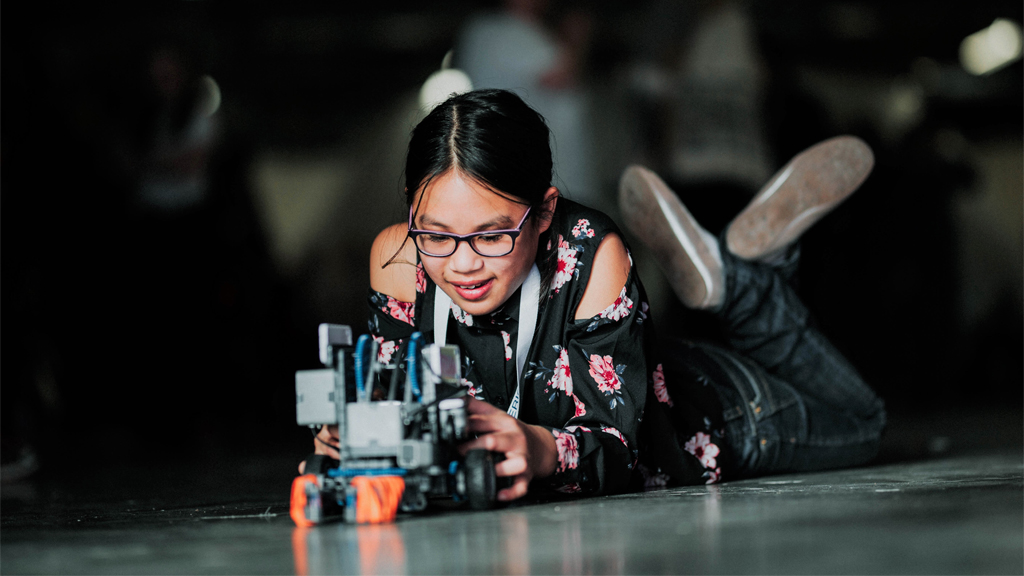Research to Practice, Practice to Research
STEM Education Outreach Involving School-Industry-University Partnerships for Scalable and Sustainable Impact
In recent times there has been a proliferation of STEM outreach activities for students of all age groups (Liston 2018a,b; Vennix et al. 2017). One of the main aims of STEM educational outreach is to develop programs and initiatives that will encourage younger generations to continue their studies in STEM subjects and consider careers in these areas. STEM outreach offers providers an opportunity to develop communication platforms and events that will challenge, inform, and effectively engage the public (SFI 2015). Outreach providers range from universities, industries, voluntary organizations, and government bodies (Davison et al. 2008). As a consequence, STEM outreach can become a catalyst to accelerate the pace of change in STEM education (European Commission 2007).
Many consider STEM outreach as informal activities only (Mann and Oldknow 2012); however, outreach programs can take place in formal environments (Dolan 2008). STEM outreach involving educational-based activities creates a “third space” in science education (Stocklmayer et al. 2010; Vennix et al. 2017). The third space can be described as where the formal school science (first space) and informal programs (second space) merge (i.e., a program that connects the curriculum content with the reality of science (Stocklmayer et al. 2010)). These STEM experiences offer a context to further develop student interests in STEM and lay the critical foundations for deep conceptual understandings (Jones et al. 2000). They also offer a chance to emphasize the relevance of STEM fields to the broader society (Veenstra et al. 2012).
This article will explore a model of STEM education outreach, involving a unique collaboration between STEM education academics at a faculty of education (specifically within a faculty of elementary teacher education), IT industry mentors, and elementary teachers in the design and delivery of a robotics program. All of the above were involved in a process of collaborative design and delivery of the robotics program; professional development workshops for teachers; and mentoring sessions with children in the classroom, reinforcing what is being taught in the curriculum but also extending learning beyond the curriculum into real-world contexts.
Effective Models of STEM Educational Outreach in Schools
STEM outreach in school engages, inspires, and enriches STEM by making STEM new, interesting, exciting, and relevant (Macdonald 2014). However, there are many factors involved in determining an effective model of STEM education outreach and its impacts on teachers and learners (e.g., the design and content; delivery; partnerships and collaborations (Stocklmayer et al. 2010)). These can also contribute to the limitations that prevent successful development and implementation of such activities (Kim and Fortner 2007). The robotics program described here involved many different interconnected elements, including:
- Continuous professional development for elementary teachers designed and delivered by STEM education academics and industry mentors in collaboration with teachers based on their needs (mentoring and supports needed to deliver a robotics program within a prescribed curriculum) and the requirements of the school curriculum (teaching pedagogies, planning, content and assessment);
- Workshops for industry mentors designed and delivered by STEM education academics and elementary teachers covering topics such as what is STEM education, effective teaching and learning pedagogies for the elementary classroom, communication to children, supports needed by the teachers within a classroom setting, and the requirements of the school curriculum (planning, content, and assessment);
- Mentoring by industry representatives and STEM education academics with elementary teachers in regional education centers and on-site at the industry and mentoring of both children and teachers together in the classroom. This involves planning robotics projects, providing advice on building and coding robots, troubleshooting, prototyping, testing, and re-testing;
- Robotics building challenges and competitions where local elementary schools compete against each other on-site at the industry facility with mentors and role-models from the IT industry; and
- The completion of a robotics project by children in the classroom, involving mentoring from industry representatives and STEM education academics delivering presentations and workshops on the real-world application of robotics to their projects.
Before providing further details of the design and delivery of the program, the following sections will explore specifically the factors affecting the successful delivery of STEM outreach programs that incorporate elements of professional development. These factors informed the design and implementation of the robotics program.
Factors Affecting the Successful Delivery of STEM Outreach Programs
Relevance
Personal relevance, real-world connections, and cohesiveness are key characteristics of successful educational outreach activities (Vennix et al. 2017). Stocklmayer et al. (2010) described factors that encourage learning about science in the informal sector as facilitating social and community interaction; presenting science as messy, human, and exploratory in nature; and addressing real and current problems. Outreach activities can contribute to students identifying the relevance of STEM personally in their own lives and envisage the future of STEM (Archer and DeWitt 2013). Therefore, organizations designing and delivering outreach programs need to understand their target audience, the participant’s context, everyday lives, needs, and interests. Teachers therefore were key contributors to the design of the robotics program as they had firsthand experience of the requirements of the curriculum (pedagogy, content, planning, and assessment), children’s interests, backgrounds, and needs in STEM education. Our robotics project that involves the design and building of robotics but also the completion of projects on robotics in collaboration with industry mentors ensures that relevance is to the fore when delivering the program in schools.
Partnerships
Educational outreach involving collaborations between industry and education has a significant role to play in encouraging young people, teachers, and the wider community to engage the broader public with relevant, topical issues. For example, big data, machine learning, and the Internet of Things (IoT) were the leading educational technology trends of 2019. Data science, Artificial Intelligence (AI), content creation, and cloud computing are now the top emerging professions for the “jobs of tomorrow” (World Economic Forum 2020). Educational outreach involving IT industries and STEM education experts can reinforce what is being taught in the curriculum and extend learning beyond the curriculum into real-world contexts (Vennix et al. 2017). Therefore, outreach activities should always be designed and delivered by a community of stakeholders (STEM education academics, industry, teachers, schools, and children). Many reports strongly emphasize the need for educational outreach programs to partner and collaborate with higher education, in particular with experienced educators and experts in the field of STEM education and outreach (Henriksen et al. 2015; Jose et al. 2017). This was a very important feature of our robotics program to ensure the successful integration of robotics into STEM teaching and learning within the elementary classroom.
Linked to the curriculum
Students have a greater potential for experiencing significant learning outcomes and achievement when educational outreach programs link with school and curricular goals (Beckett 2008; Bodilly and Beckett 2005; Cooper et al. 2000; McLaughlin and Phillips 2008). STEM educational outreach should link and integrate into the everyday workings of the formal sector of STEM education by supplementing school curriculum work and pedagogical skills (Gomes and McCauley 2013; Wilkerson and Haden 2014). A truly effective program is one that deliberately connects the curriculum content with the reality of STEM. Individuals delivering outreach programs need a strong background knowledge and understanding of the curriculum in schools to identify needs within the education system. The design of our robotics program involves input and implementation by experienced educators, as they were able to provide information on the requirements of the curriculum (content to cover, specific pedagogies required, planning and assessment criteria, the need for differentiation in the classroom, and supports required for teachers to implement a robotics program within a very prescribed and overcrowded curriculum) to all project partners (i.e., industry and STEM educators).
Training of facilitators
The quality, background, and training of facilitators that deliver educational outreach programs is key to the success of STEM educational outreach programs. For example, a facilitator that has little or no background knowledge of the education system, effective pedagogies, and science communication can have a negative impact on students. Outreach activities need teachers and facilitators that are familiar with the primary learning environment to support teachers to implement inquiry-based, hands-on STEM teaching and learning activities (Young et al. 2017). The STEM Education in the Irish School System report highlights that “engagement needs direction, and enterprise and educators need to learn to speak the same language” (DES 2016, p.67). Therefore, a challenge in STEM outreach is the selection of appropriate personnel to deliver outreach programs. Our robotics program includes not only professional development for teachers but also for industry mentors to ensure all stakeholders were familiar with STEM education, effective teaching, and learning pedagogies for the elementary classroom, supports needed by the teachers within a classroom setting, and the requirements of the school curriculum (planning, content, and assessment).
Professional development
Continuous professional development (CPD) plays a significant role in developing teacher effectiveness (Coolahan 2003). CPD builds on existing knowledge and understandings and aims to ensure that teachers have access to the most up-to-date knowledge (Starkey et al. 2009). Effective CPD in science education has the ability to improve teachers’ pedagogical capacities, lead to more effective teaching, and enhance learning outcomes (Murphy et al. 2015). In any STEM educational outreach program delivered in schools, a professional development component for teachers is vital for the success of the program. CPD can enhance engagement, build capacity, and support teachers in delivering STEM concepts, pedagogies, and curriculum (Taylora and Govana 2017). Therefore, outreach initiatives that incorporate professional development provide relevant, up-to-date STEM content knowledge and pedagogical knowledge (teaching and learning strategies). This can influence a students’ experience and perception of STEM as teachers play a significant role as advocates for STEM and through their work can encourage students to engage with STEM. The robotics program outlined here provides multiple opportunities for professional development for teachers during the academic year through summer courses and regular off-site (in industry facilities, education centers) and in-school workshops. The professional development sessions are designed and delivered by academics in STEM education and industry mentors in collaboration with teachers based on their needs (mentoring and supports needed to deliver a robotics program within a prescribed curriculum) and the requirements of the school curriculum (teaching pedagogies, planning, content, and assessment).
Design of a Robotics Program for Elementary Teachers and Children
The robotics program involves collaborations between STEM education academics at a faculty of education, mentors from a multinational IT company, and elementary teachers and children. All stakeholders are involved in a process of collaborative design, reinforcing what is being taught in the curriculum but also extending learning beyond the curriculum into real-world contexts. The program involves 40 elementary schools from the midwest region of Ireland (N = 80 teachers, N = 1200 children (9–12 years old)). The industry mentors voluntarily signed up to the project and volunteered their time during their workweek as part of the company’s corporate social responsibility (CSR) objectives. They involve employees in a variety of roles, such as programmers, project managers, engineers, and talent acquisition. Each of the 40 schools were allocated a specific mentor from the IT company to work with for the academic year. Many mentors (N = 10–15) are allocated three or four schools to work with in any one year. This not only involves monthly professional development and mentoring of teachers but also the co-delivery of lessons in the classroom and mentoring sessions with children at the industry site and in the classroom.
The robotics program incorporates many different elements that are interconnected (described previously). These features were based on research carried out on the factors affecting the successful delivery of STEM outreach programs (Table 1).
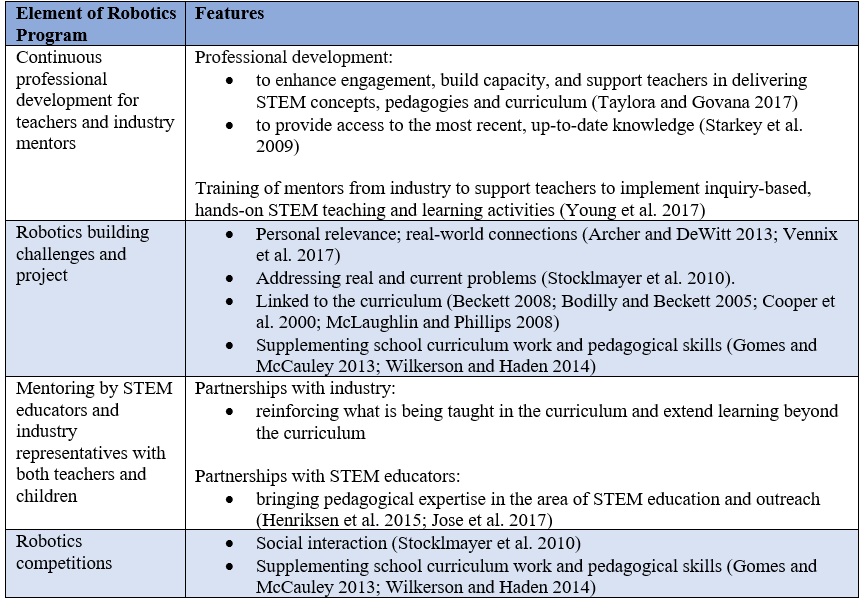
click here for larger image
Continuous Professional Development for Teachers and Industry Mentors
Summer course for elementary teachers and industry mentors
A weeklong summer course is delivered every year by university academics in STEM education and experienced elementary teachers that have been previously involved in the robotics program. The course focuses on using robotics to support an inquiry process and enable children to work on solving complex, real-world problems by engaging in collaborative project-based learning activities that go beyond the classroom. Throughout the course, participants engage in a variety of interactive, participant-led, teacher-led, and practice-based learning opportunities, working both in an individual and group capacity (Figure 1). An important aspect of the professional development sessions is to explore ways in which the teachers can integrate robotics across the elementary curriculum, rather than as an add-on to a curriculum that is very overcrowded (Figure 2a and 2b). This approach was taken based on published research on successful features of school-university partnerships. Key features of effective professional development within such partnerships are content-focused involving active learning approaches and the provision of teaching and learning pedagogies and materials (Lehman et al. 2014). Table 2 includes details of the aims of the course along with methodologies that the teachers and mentors carry out during the weeklong summer course in robotics (30 contact hrs).
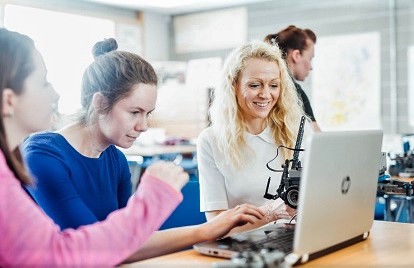
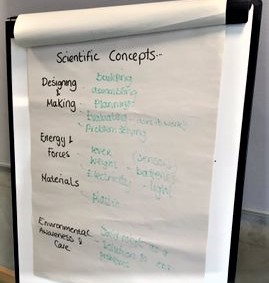
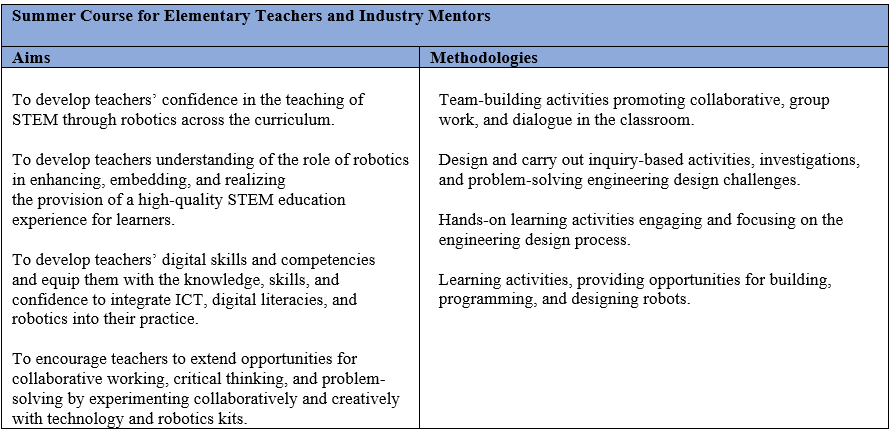
click here for larger image
Ongoing support and mentorship for teachers
At the beginning of the academic year, teachers begin activities with their children on building and programming robots, applying what they learned during their summer course. For the duration of the robotics program from September to January, a class of elementary children, from 9 to 12 years old, work in teams on a specific robotics challenge that involves designing, building, and programming a robot. They also work on a STEM project where the children design and develop a four-minute video presentation on a topic in robotics. Robotics topics from previous years are outlined in Table 3.

click here for larger image
As part of the ongoing support and mentorship provided to these teachers, from September – January, teachers come together once a month with their mentors (i.e., experts in STEM education and the IT industry) where they are provided with professional development workshops in supporting their activities in the classroom. The workshops held in education centers and/or onsite in industry involve open dialogue, sharing ideas and practices on what is working and what is not successful in the teachers’ classrooms, and troubleshooting any problems they may be having with their robot design (Gajda 2006). Key features of these workshops involve mentoring of elementary teachers, peer support, and trying things out in a supportive, encouraging, and collegial environment (Li et al. 2009) (Figure 3 a, b, and c).
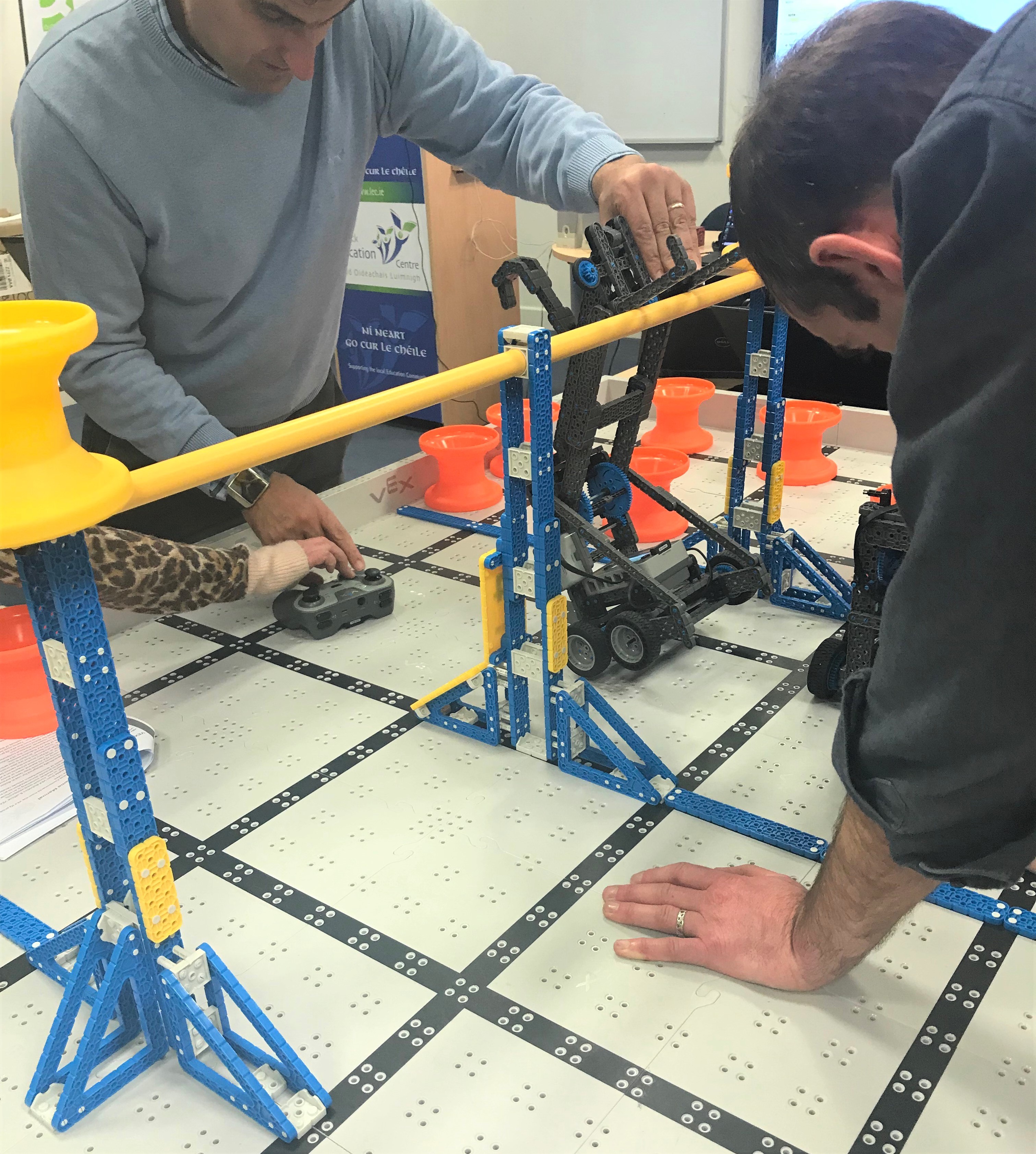
The STEM education academics bring the pedagogical and educational theory aspect to the workshops and representatives from the IT industry bring their vast knowledge of coding and robotics along with knowledge on the application of robotics, machine learning, and coding. The workshops involve all partners working together in the co-creation of robotics STEM lessons that the teachers then try out in their classrooms, co-facilitated by mentors from university and industry settings (Hamilton et al. 2021; Lehman et al. 2014).
The teachers themselves—with varied backgrounds and experiences of the robotics program—share their practical tips with each other, supporting each other as they navigate the robotics program. This community of practice involving teachers, STEM education academics, and IT sector representatives can then serve as a means of meaningful engagement and professional development (Gajda and Koliba 2007).
Another important aspect of the program involves school and industry visits for teachers and children. This involves mentoring by industry mentors and academics in STEM education with elementary teachers on-site at the industry after school hours where they plan robotics projects, provide advice on building and coding robots, troubleshoot, prototype, test, and re-test. During these visits teachers co-create sessions on robotics, which they then co-facilitate at a later date back in the classroom. Separate site visits during the school day provides an opportunity for children to work with role models from the IT industry and learn about the everyday applications of coding and robotics. They also complete robotics building challenges and competitions where local elementary schools compete against each other on-site at the industry facility with their IT industry mentors (Figure 4 a, b, and c).
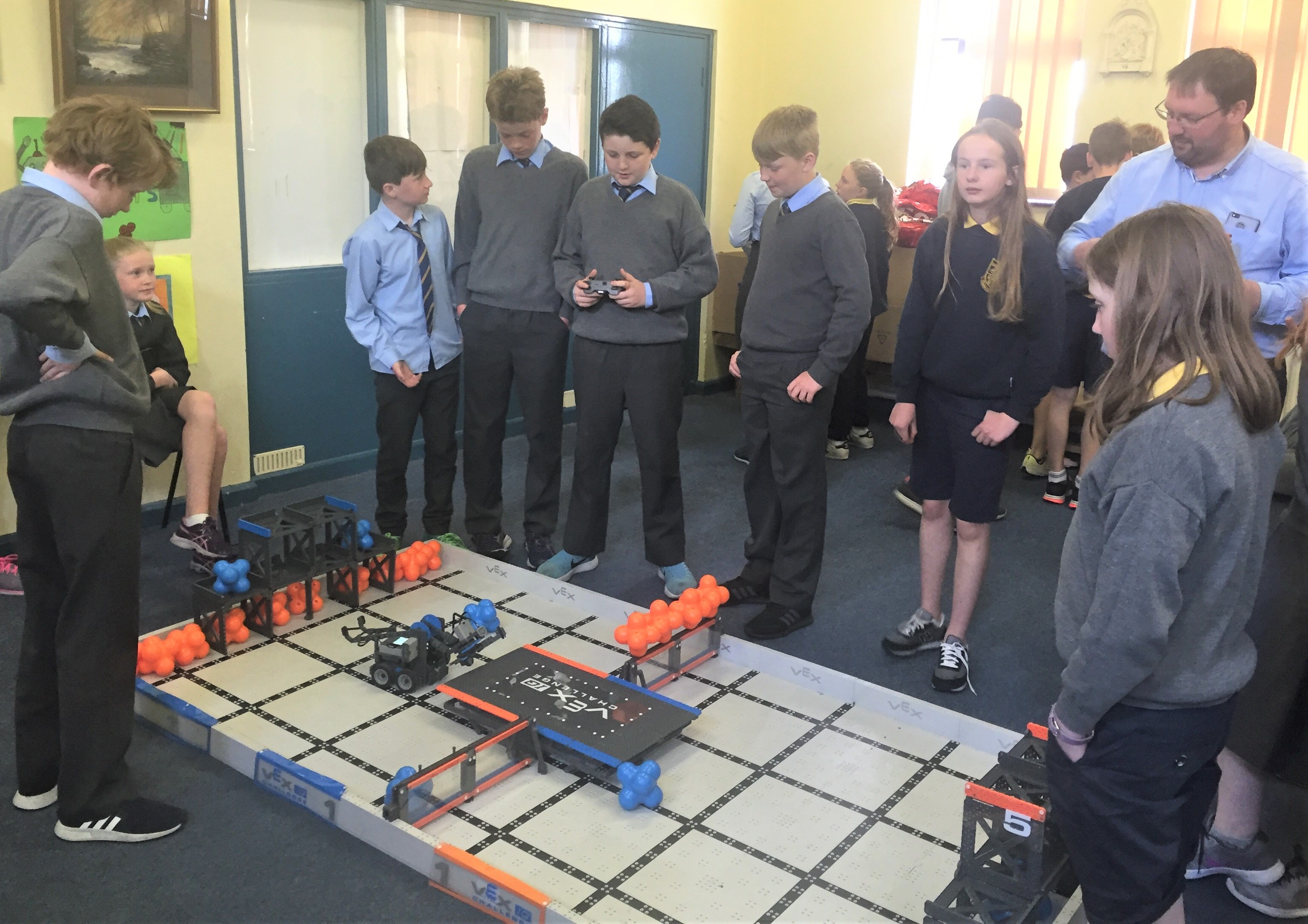
Robotics Competitions
Every January/February all schools involved in the robotics program come together to present and showcase their STEM projects. This end-of-program celebration allows all schools to share their work and for their robots to battle it out against others in a robotics competition. There is a great sense of achievement at this event where children and teachers showcase their interesting research into robotics in everyday life. This aspect of the program ensures that the program is relevant and connected to the real world (Vennix et al. 2017). The competition can be quite a challenge where children have to think on their feet, troubleshoot, problem solve, code, build and rebuild their robots (Figure 5 a and b; Figure 6 a, b, and c).
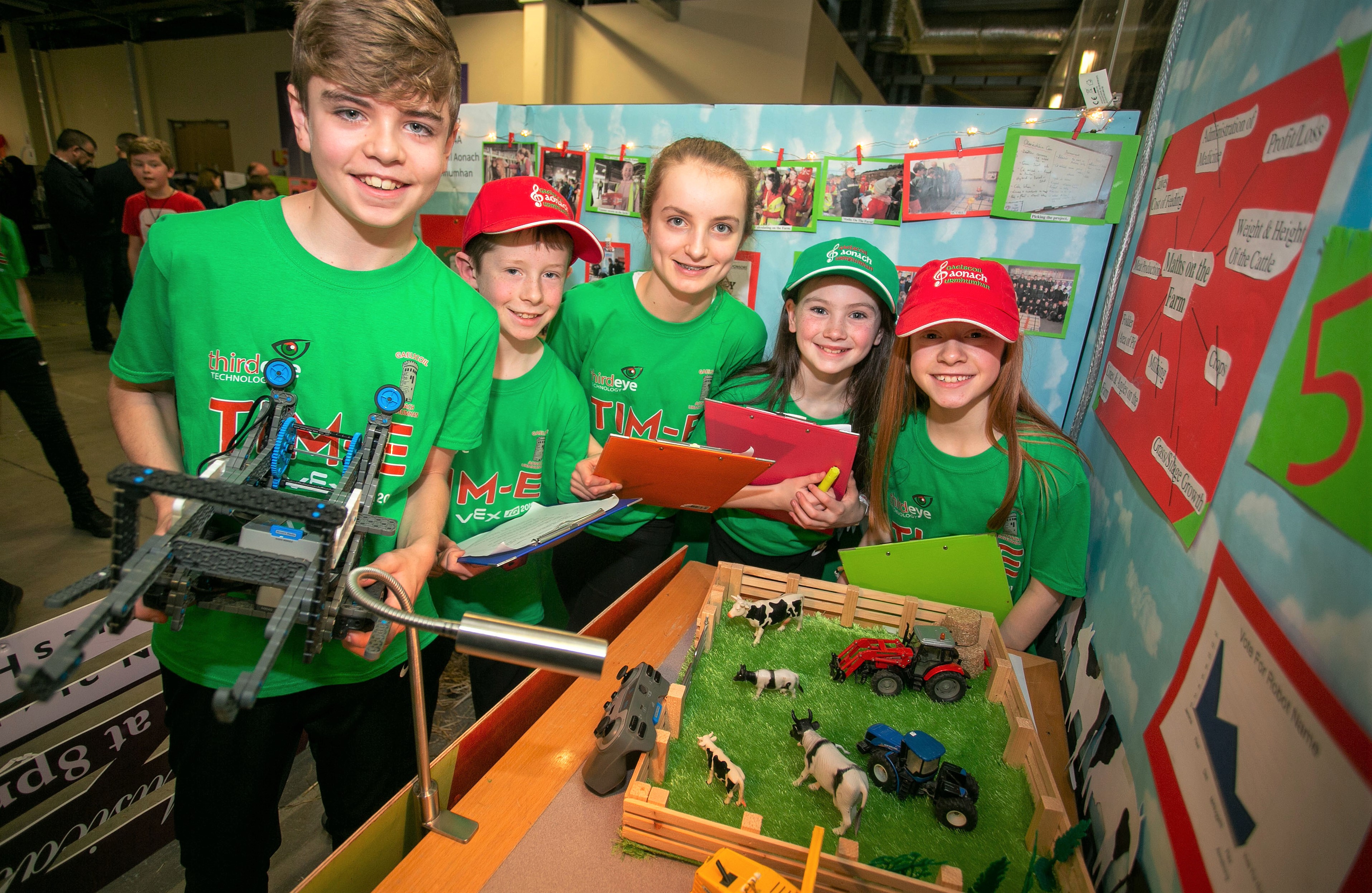
Research Methodology
To explore teachers’ experiences of a collaborative approach to robotics education involving industry-university partnerships with schools, qualitative data was gathered from the teachers after the robotics program through focus groups (Merriam 2009). Three 40-minute focus groups were held with 13 elementary teachers (2 focus groups with N = 4 teachers, 1 focus group with N = 5 teachers). The focus groups explored the teachers’
- overall experience of the robotics program,
- impact of the course on a professional level,
- professional development and mentoring during the school-industry-university partnerships, and
- opportunities that exist when delivering STEM outreach programs involving school-industry-university partnerships.
Qualitative data was analyzed using bottom-up or inductive data-driven thematic analysis, applying Braun and Clarke’s (2006) 6-step framework to thematic analysis (Step 1: Become familiar with the data, Step 2: Generate initial codes, Step 3: Search for themes, Step 4: Review themes, Step 5: Define themes, Step 6: Write-up). Codes were assigned to portions of data and later organized into categories that were then presented in a series of themes (Saldana 2021).
Themes that emerged from coding the qualitative data included:
- Collaborative school-industry-university partnerships support teachers in both their personal and professional development.
- Codes: impacts, goals, delivery, teaching, professional development, needs, supports
- Mentoring of teachers during school-industry-university partnerships provides teachers with meaningful experiences with external stakeholders.
- Codes: mentoring, relationships, different perspectives, knowledge, experience, skills, expertise
- Co-design and co-delivery of lessons during school-industry-university partnerships reinforces what is being taught in the classroom and extends learning beyond the curriculum.
- Codes: collaboration, co-design, co-delivery, real-life application, innovation, motivation, focus, challenges, reputation
- School-Industry-University Partnerships require an intense level of commitment and regular contact among all stakeholders, having implications in achieving further scalability and sustainability into the future.
- Codes: time, commitment, workload, momentum, scalability
Results
Personal and professional development of teachers
The teachers were asked about their overall experiences of the robotics program and whether the program lived up to their expectations. All teachers agreed that it was a positive experience with many stating that it was “exciting and innovating for the children” and that they “learned so much about robotics and coding.” One teacher stated that it was “such an eye opener for me in what is possible in the classroom, great experience.” This was the resounding sentiment of all teachers interviewed.
The teachers were asked “Did they achieve what they set out to achieve by partaking in the robotics program?” All the teachers mentioned that they had developed professionally and that the ongoing mentoring and professional development workshops delivered as part of the program helped them in achieving their goals of bringing innovative robotics into the classroom. A running theme throughout the interviews involved the importance of the mentoring and support received by teachers from STEM education academics and IT industry mentors. An example of their comments included:
“I wanted to be more innovative in my teaching and wanted to learn more about robotics, this program with the professional development workshops really helped me achieve this.”
“I delivered a robotics program successfully with my class. I learned so much about coding and robotics. Also, the support received from the mentors was invaluable. I could not have done it without them.”
They mentioned the importance of the continuing professional development workshops where they “could bring the robot to troubleshoot” and “it was so useful to be provided with support on how to teach robotics and the actual knowledge and content we needed to know to continue to incorporate robotics in the classroom.”
Mentoring during school-industry-university partnerships
The teachers’ comments about the industry-university partnerships with the schools highlighted the importance of such a mutually beneficial model of educational outreach, where STEM educational and industry experts worked with teachers in the co-creation of activities for the elementary classroom: “I thought the model used in this program was very effective where we had experts from education and industry delivering the program, supporting teachers and children in the classroom.” All stakeholders brought different perspectives and varying levels of knowledge and experience in STEM education and IT skills to the project. They mention:
“I had never worked with industry before and never thought someone from the IT sector could help me in the classroom. How wrong could I have been.”
“I learned that there are experts out there with knowledge that can help me in the classroom.”
Developing a relationship with the mentors was highlighted as an important aspect of the program. The continuous professional development and ongoing support in the schools allowed teachers to develop meaningful relationships with mentors, rather than on-off, ad-hoc professional development programs that can often be the norm in Ireland. One teacher stated that they were “initially very daunted by the experts but as I got to know them, I realised all of us had something to bring to the table.”
Collaborative partnerships during school-industry-university partnerships
The teachers also highlighted the importance of the collaborative approach to the partnership, where everyone was involved in the design of the program in the classroom and that the teachers’ practical experience and feedback contributed to the design and delivery of the professional development workshops:
“I really enjoyed designing sessions with the mentors and then delivering them in the classroom together, a great learning experience for everyone.”
“We were asked prior to the workshops what we needed help with and that made the workshops very focused and dealt with any challenges we were having.”
The overall sentiment was that “it would have been difficult to do the project without help” and support from the mentors. One teacher also commented that “having mentors in the classroom brought a sense or importance to the project for the children.”
School-industry-university partnerships require an intense level of commitment
The teachers were asked their thoughts on any opportunities that exist when delivering STEM outreach programs involving school-industry-university partnerships. Their suggestions were very insightful, involving ideas on how to expand the program activities and practical actions to inform the design and development of a more scalable program into the future. They mentioned the importance of continuing the professional development and mentoring with representatives from academia and industry. Their comments included “The workshop explained the workload and the needs and helped with delivering the program on a practical level.” and “It was so useful to be provided with support on how to teach robotics and the actual knowledge and content we needed to know continue to incorporate mentoring in the classroom, that kept the momentum going with the class.” This was important as the “mentoring in the classroom kept the momentum going with the class.”
Many comments from the teachers highlighted that school-industry-university partnerships require an intense level of commitment and regular contact among all stakeholders and this has implications in achieving further scalability and sustainability into the future: “It’s very worthwhile but the teachers need continuous CPD and in class support.” They also mentioned increasing the supports from monthly to “fortnightly visits from mentors.” However, the mentors from the university and IT industry are volunteering a significant amount of time from their workweek on this project. Mentors are allocated 3 or 4 schools to work with in any one year. As previously outlined this not only involves monthly professional development and mentoring of teachers but also the co-delivery of lessons in the classroom and mentoring sessions with children in the industry site and in the classroom. On top of their day job, they have limited capacity and resources to further scale up the frequency of professional development and mentoring sessions.
At the monthly professional development sessions, the development of communities of practice was promoted and every workshop involved teachers sharing ideas and practical tips with their peers. However, from the teachers’ comments on how we could improve the program it was clear that the robotics program needs to develop the community of practice strategy to a greater extent moving forward into the future. Many teachers stated how much they learned from the mentors with little mention of the invaluable peer-learning that took place at the professional development workshops. Many of the teachers suggested setting up a network of schools to “support each other through the program by sharing expertise, problems, solutions, ideas, etc.” It is clear that the concept of communities of practice will have to be developed into the future to make this program more sustainable and scalable. One improvement that could help with the sustainability of the program was mentioned by many teachers: formally pairing schools to work with each other. Currently teachers are paired with mentors from industry and higher education. One teacher mentioned “maybe for newbies, you could buddy schools / class teachers so they could chat and gain confidence in what to do etc.” Another mentioned “school groupings which include at least one experienced school with a less experienced school.”
Discussion
This research showed that collaborative school-industry-university partnerships can provide significant educational value to schools and STEM education outreach programs (Stocklmayer et al. 2010). Incorporating an effective model of continuous professional development and mentoring within a robotics educational outreach program was key to ensuring the quality of delivery and experience of all stakeholders.
The professional development workshops and mentoring delivered to both teachers and mentors from the IT industry ensured that everything covered was grounded in educational theory. This program of professional development also involves school-based learning that is integrated with day-to-day school processes; teachers defining their support requirements and developing opportunities for professional development; meeting individual teachers’ needs but being primarily collaborative; providing opportunities for teachers to develop a theoretical understanding of the knowledge and skills learned; and being continuous and ongoing, with follow-up and support for further learning (Hawley and Valli 2001). The components of professional development activities that supported the teachers’ work included monthly collaborative active learning opportunities over seven months (Barrera-Pedemonte 2016). This model is a move away from the norm as teachers still report participating in more non-school than school embedded professional development (OECD 2015). Embedded professional development refers to teacher learning that is grounded in teachers’ daily professional practices, the school context, where teachers collaborate with their same-school colleagues. Teachers have reported more positive impacts on their classroom teaching from school than non-school embedded professional development (OECD 2015).
All stakeholders had a shared commitment to the program (Mattessich et al. 2001). The diversity of perspectives from teachers, STEM education academics, and employees from the IT industry contributed to the collaborative nature and shared ownership of the program (Lehman and Capobianco 2012). Such supports help elementary teachers feel comfortable about taking risks while engaging in STEM (Margot and Kettler 2019). The success of the partnership can also be attributed to all stakeholders valuing the knowledge and experience of all involved (Loucks-Horsley et al. 1998). Academics in STEM and mentors from the IT industry valued the practical expertise of the teachers, and the teachers respected and valued the disciplinary expertise and content knowledge of their mentors (Li et al. 2009).
The involvement of industry in an educational outreach program allowed for scalability and the expansion into 40 schools in a region. This would not have been achievable without the extra support and resourcing from industry. We are now exploring how to move forward in making the program even more scalable and sustainable into the future. The embedded professional development has assisted in our aim in developing sustainability within the educational outreach program. However, the STEM academics and industry representatives who manage the program—with limited capacity and resourcing to scale up the project—need to reconsider and include an even greater level of teacher involvement and commitment to peer-mentoring. It was clear from the teachers’ comments that a greater focus needs to be placed on the community of practice strategy within the program. A concrete action from the teachers’ feedback will involve formally pairing schools to work with each other, in a type of budding and peer-mentoring system.
Conclusion
Stronger and more meaningful partnership between schools and science outreach providers have been called for (Gomes and McCauley 2012), and there have been a significant number of reports, policies, and strategies focusing on a move toward fostering linkages between the educational and research institutions and industry to ensure that the educational content is informed by “real world” needs and experience. However, as can be seen from the robotics program described here, these partnerships involve a significant amount of resourcing, time, and management, but most importantly must involve mentors and facilitators that are familiar with the school learning environment and pedagogies so that they can support teachers to implement high-quality STEM teaching and learning experiences (Young et al. 2017). Insights from teachers on their experiences of this robotics outreach program, involving industry-university partnerships with schools, will now inform future planning and improvements in how we can continue to work on becoming more scalable and sustainable into the future (Gardner 2011; Wilkerson and Haden 2014).
Maeve Liston is Director of Enterprise and Community Engagement and Associate Professor in Science Education at Mary Immaculate College in Limerick, Ireland.
Interdisciplinary Professional Learning Science and Engineering Practices STEM Elementary Informal Education



